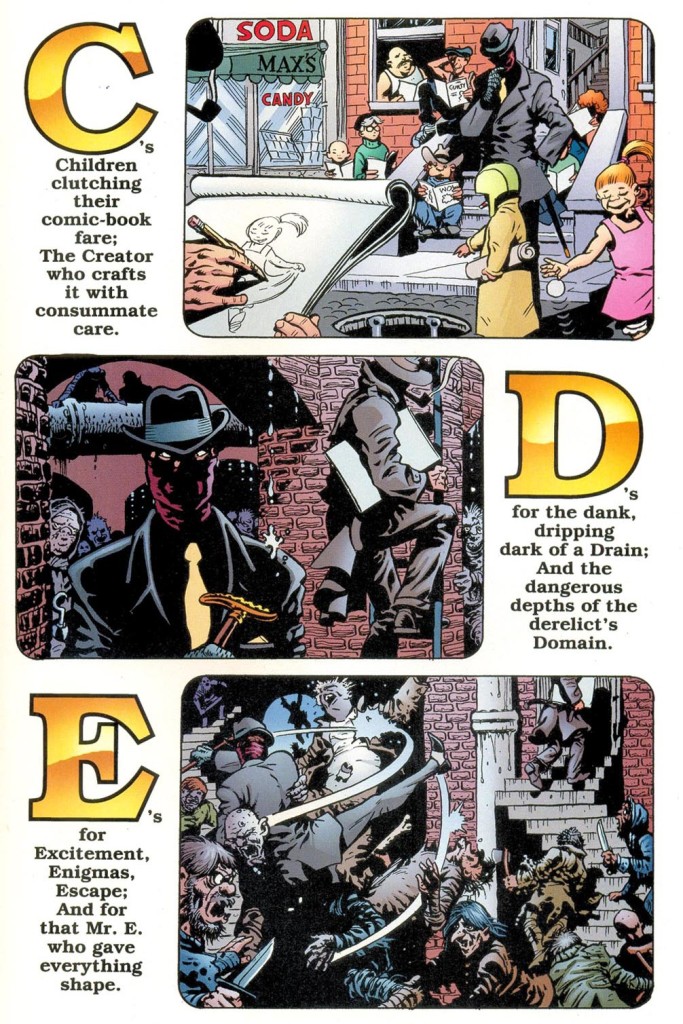If you read the last posts, you know that this month I’ve been discussing eccentric vigilante comics.
Hence Greyshirt.
I have little doubt that the seeds for Greyshirt grew from Alan Moore’s contributions to The Spirit: The New Adventures, in which Moore became one of the many creators that tried to revive Will Eisner’s The Spirit. Except for the sake of nostalgia, this was a pointless exercise, since what made the original comic so amazing wasn’t the Spirit himself or his world, but rather Eisner’s willingness to play with the medium’s potential for storytelling. Either because Moore acknowledged this or because The New Adventures was cancelled and he could no longer work directly with Eisner’s hero, in the late 1990s the bearded British genius decided to create his own version of the character in the form of Greyshirt.
A masked vigilante whose secret identity (Franky Lafayette) was left for dead and who now operates out of the retro-futuristic Indigo City, Greyshirt is a blatant knockoff of the Spirit, but like I said the point isn’t the character – it’s the type of stories he finds himself in. And sure, there is a clear element of pastiche (the way Greyshirt is often a background player in the narrative, the way each first page integrates the credits into the art). However, Moore and Greyshirt’s artist/co-creator Rick Veitch pull off what most official revamps of The Spirit have failed to achieve, which is to deliver comics that push the techniques of storytelling in ways that are as original, smart, and entertaining as what Will Eisner did. In that sense, Greyshirt transcends the mere pastiche, thus truly paying tribute to Eisner’s legacy.
For example, take ‘Hit and Run!’ (Tomorrow Stories #7), drawn entirely with the same POV, from the back of a taxi cab. Or take ‘How Mel Got Down With Science Hero Style!’ (America’s Best Comics 64 Page Giant), which tells a hardboiled yarn through clothing advertisements. Or better yet, take the phenomenal ‘How Things Work Out’ (Tomorrow Stories #2), in which each page shows you the inside of a building owned by gangster Spats Katz, with each floor corresponding to a different time period:
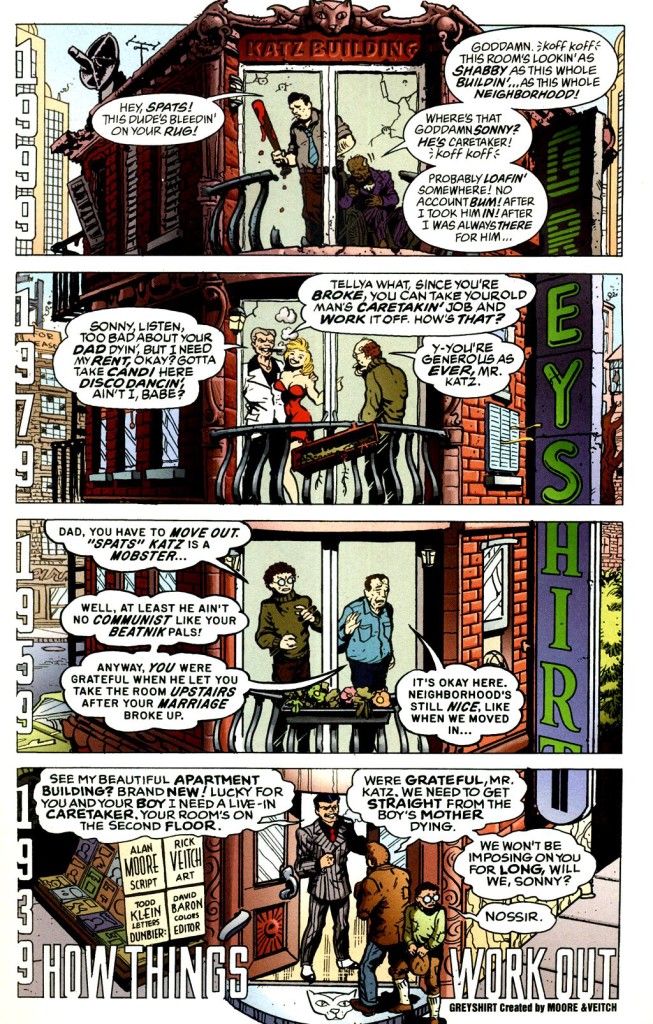 Tomorrow Stories #2
Tomorrow Stories #2
It’s ingenious enough that one can pretty much read ‘How Things Work Out’ in various directions – for instance, you can read the saga of each floor at a time, flipping back and forth to the first page, perhaps starting with the ground floor and then moving up chronologically. Yet if you do follow the conventional reading order the narrative is even more rewarding, not only because panel transitions are structured around wordplay, but also because you get a greater sense of the characters looking back (down) to the past, which further deepens the comic’s theme. And all this in eight pages! (Well, nine if you count the issue’s cover.)
Greyshirt’s early adventures were all similarly short (again, like Will Eisner’s The Spirit). They came out in America’s Best Comics’ awesome anthology Tomorrow Stories, alongside series with completely different styles, including the experimental erotica The Cobweb and three hilarious variations of Mad-like, anything-goes absurdity: Jack B. Quick, The First American, and Splash Brannigan.
In the case of Greyshirt, the overall tone oscillated between film noir and The Twilight Zone. If you’re into the former, look no further than Greyshirt’s very first story, told from the perspective of an amnesiac who realizes he is a hunted serial killer (amnesia is, of course, a classic noir trope and I suspect Eisner himself must have been visually influenced by films like Crack-Up and Spellbound). For the latter, check out the knockout twist ending on ‘Day Release’ (Tomorrow Stories #6). And for something more outside the box – and proof that Moore’s off-color comedy was never far behind – have a look at the insane production number in ‘Greyshirt the Musical!’ (Tomorrow Stories #9):
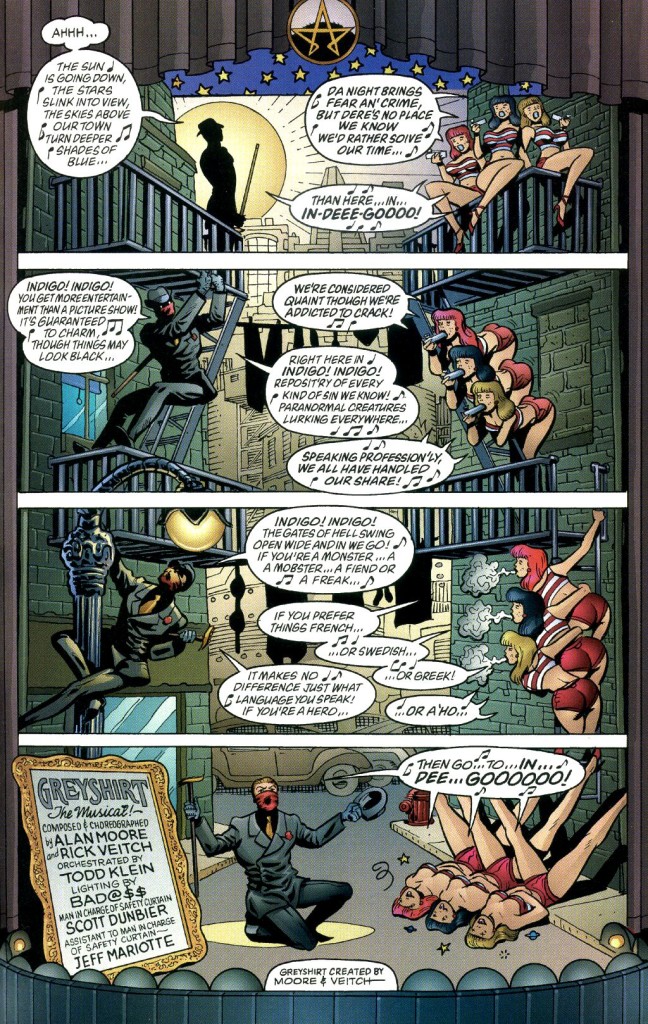 Tomorrow Stories #9
Tomorrow Stories #9
Greyshirt spun off from Tomorrow Stories into his own mini-series, Greyshirt: Indigo Sunset, now fully written by Rick Veitch (except for the goofy 6-page ‘The Butt Kicks Back!’ by Dave Gibbons). Veitch is an interesting writer with an encyclopedic knowledge of old comics, a knack for the macabre, and the courage to pursue bafflingly strange story ideas. And while his dream diaries and truther one-shot may not appeal to everyone, Veitch has produced his fair share of cult classics, including The One and his run on Swamp Thing, as well as unsung gems like the poetic post-9/11 graphic novel Can’t Get No or the War on Terror satire Army@Love.
In Indigo Sunset, Veitch built upon the short origin story told in ‘The Making of Greyshirt’ (Tomorrow Stories #3), expanding Franky Lafayette’s pre-Greyshirt background while also developing several supporting characters who had popped up in the regular series. This was basically a gangster saga, but with an eerie horror threat in the form of the Lure – a hypnotic tentacle monster that haunted Indigo City’s mine shafts.
The mini-series was a narrative tour de force, as each issue featured tales and vignettes from different eras that were gradually woven together into one massive tapestry. Even the misleading covers were cleverly integrated into the whole. Moreover, Rick Veitch, in full command of his craft, drew on the aesthetics and tropes of multiple comic traditions, such as children’s strips, romance comics, and down-and-dirty crime tales. Hell, he even included a takeoff of Scott McCloud’s Understanding Comics!
Indeed, Indigo Sunset was ultimately a metafictional love letter to the rich history of the medium, from Tijuana bibles to comics’ ironic appropriation by pop art. Not only that, but Veitch also sneaked in quite a few nods to other series published by America’s Best Comics (Top Ten, Promethea, Tom Strong) as well as to earlier Greyshirt adventures. Notably, the second issue was packed with winks to the above-mentioned ‘How Things Work Out,’ including a page that revisited that story’s layout of the interior of Spats Katz’s building:
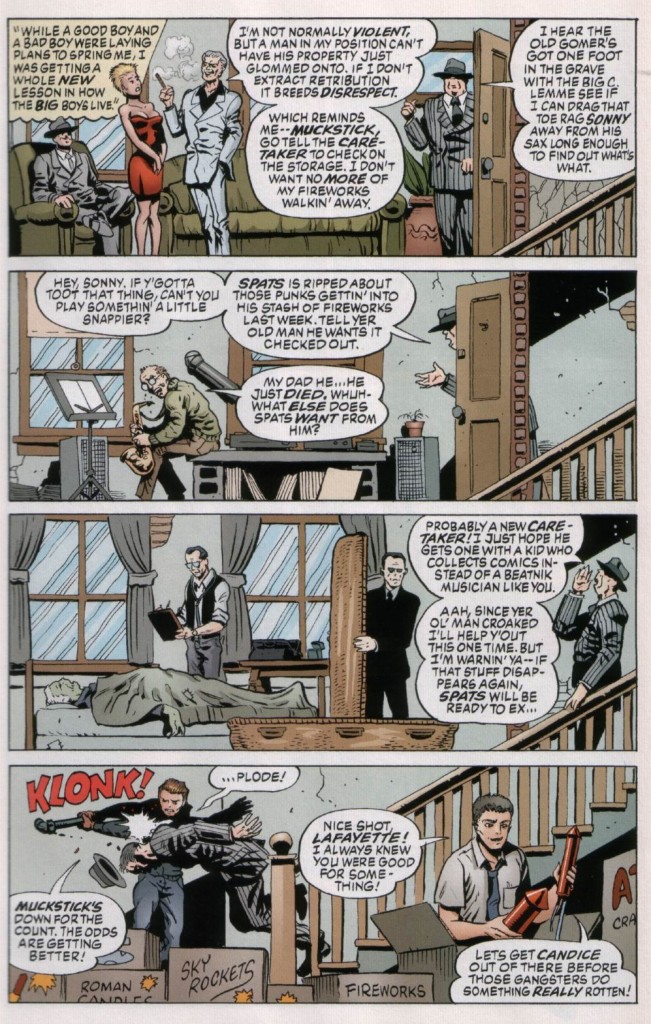 Greyshirt: Indigo Sunset #2
Greyshirt: Indigo Sunset #2
In yet another meta move, each issue finished with a bunch of pages from the local newspaper Indigo City Sunset, including news stories, gossips, an opinion section, a sports page, adverts, horoscopes, entertainment news, an amusing advice column, and, of course, a number of old-school comic strips. Not only did these newspaper excerpts help provide exposition, they also developed the various subplots (especially if you read between the lines) and rewarded fans with Easter Eggs. Plus, they further fleshed out the history and everyday life of Indigo City – it is not going too far to say that in six issues Rick Veitch managed to give the place as distinctive a personality as that of comic cities like Astro City or Opal City (not to mention Gotham!).
Neatly, Greyshirt shared Indigo City with another masked vigilante from the pages of Tomorrow Stories – the Cobweb. Created by Alan Moore and Melinda Gebbie, the voluptuous Cobweb and her sidekick Clarice were a couple of adventuresses whose tales apparently span centuries (later, a couple of gorgeous specials written by Steve Moore explained that they belonged to a long lineage of parthenogenetically-produced daughters). As such, this duo were the most versatile characters in Tomorrow Stories, starring, for example, in the noirish ‘Eurydice: A Retrospective’ (Tomorrow Stories #3), with its purple prose worthy of an old pulp mag; in the existentialist ‘La Toile dans le Chateau des Larmes’ (Tomorrow Stories #5), with its surrealist collage; in the newspaper serial pastiche ‘Brand New Adventure Starts Today!’ (Tomorrow Stories #8), with its cartoonish humor; and in the underground comix spoof ‘Ye Head Shoppe’ (Tomorrow Stories #7), with its over-the-top satire of the limits of women’s liberation in the 60s’ counterculture.
Such a wide range of styles benefitted from the fact that the talented Melinda Gebbie was involved in most Cobweb stories, providing incredibly diverse art to suit each particular type of comic:
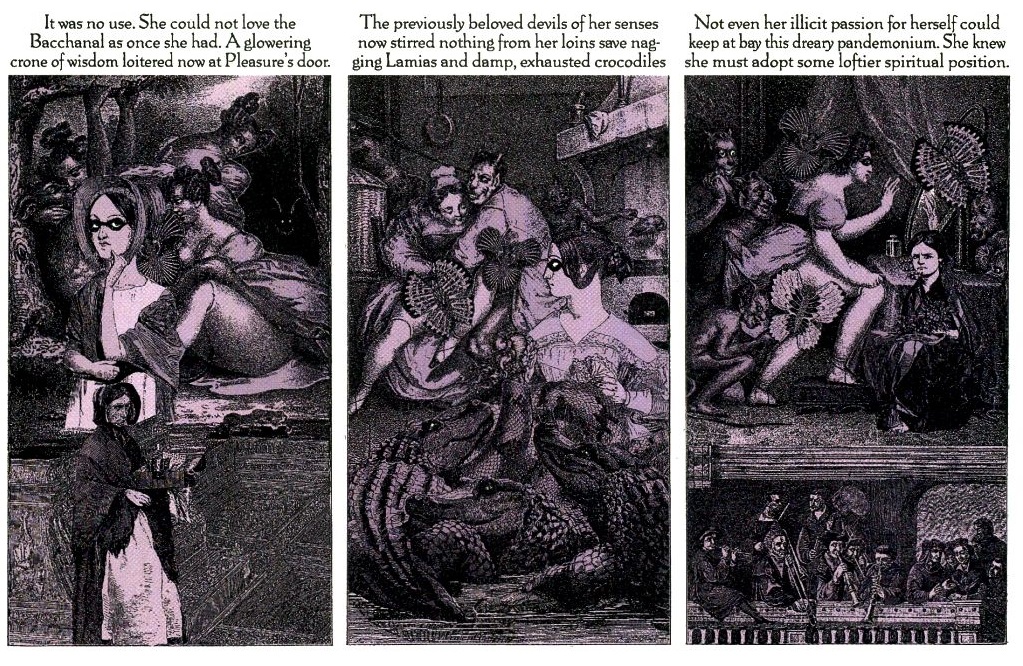 Tomorrow Stories #5
Tomorrow Stories #5
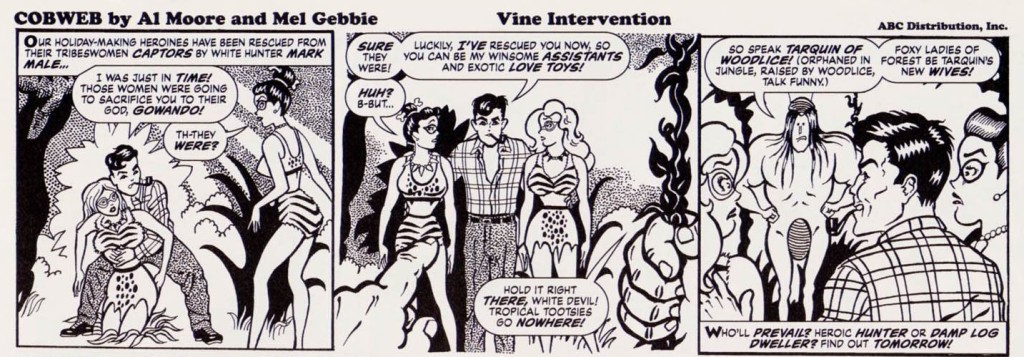 Tomorrow Stories #8
Tomorrow Stories #8
It was all written with a naughty tongue in cheek, especially the twisted ‘Li’l Cobweb’ (Tomorrow Stories #4), which wickedly pushed the subgenre of kid comic strips like Little Lulu into the fucked up world of grown-ups. (That said, Alan Moore and Melinda Gebbie didn’t go nearly as far as they did in their critically acclaimed sex comic Lost Girls.)
Given the Cobweb’s kinky promiscuity and Greyshirt’s habit of falling for the wrong dame, you get no points for guessing what happened when those two finally crossed paths under the Indigo moon…
But let me finish by returning to Will Eisner, whose groundbreaking work on The Spirit was an acknowledged inspiration for Greyshirt. In the last comic they did together with the character, Alan Moore and Rick Veitch fully blurred the line between the two universes – ‘A Greyshirt Primer’ (Tomorrow Stories Special #1), published after Eisner’s death, was a moving homage to the master, done in the style of one of his primer stories and featuring a ton of references to his works:


